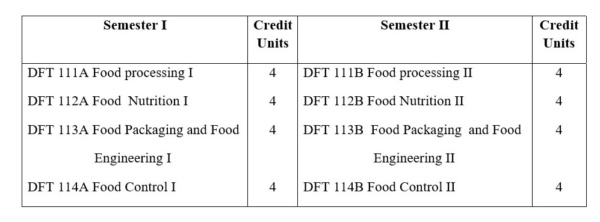Diploma
Courses in Diploma in Food Technology (One-year Program, Total Credit Units 32)

# In partial fulfillment of the requirements for the award of Post-diploma in Food Technology, Diploma Students must take part in occasional field trips (to plants / factories) / project assignments, related to their field of studies, as deemed necessary by the Department of Industrial Chemistry and Submission of Term Paper at the end of the second semester.
Course Description
Food Processing I and II
This module involves the study of sources of fats and oils, their properties and various processing methods as well as processing of milk and milk products, meat, fruits, vegetables, and manufacturing methods of fruit juice and beverages.
Learning Outcomes
At the end of the course, the students must be able to:
-Understand the sources and properties of fats and oils, milk and meat, fruits and vegetables and their various processing methods.
-Manipulate the products based on fats and oils such as butter, magarine, shortening, mayonnaise and salad dressing.
-Adapt to produce fruit juice, carbonated and non-carbonated beverages such as beer, wine, coffee and tea.
-Apply the milling, processing, fermentation techniques to manufacture of value-added cereal products such as bread, cornflakes and corn starch etc.
-Assess different preservation techniques of cereal and cereal products.
-Analyze the spoilage of cereals and cereal products, and range of fermentation processes.
Food Nutrition I and II
This course aims to provide knowledge in the nutritional value of food on the body as it relates to cholesterol, fat, salt and sugar intake. Knowledge of good nutrition that is vital for good health, disease prevention, and essential for healthy growth and development of children and adolescents is also achieved after this course.
Learning Outcomes
At the end of the course, the students must be able to:
-Understand the nutritional values of food on the body.
-Understand the requirements of good health, disease prevention, and essential for healthy growth and development of children and adolescents.
-Understand the structure and properties of biologic molecules.
-Understand the nutrition requirement for pregnant and lactating mothers and prevention of malnutrition.
-Synthesize the nutritive value and processing of supplementary foods, their preservation and function.
-Understand the handling and storage of foods with regard to their physico-chemical characteristics.
Food Packaging and Food Engineering I and II
This course introduces function of food packaging, classification of packaging and packaging containers in food industry and the testing methods of packages. After this course, students can be able to design the process plants and calculate the engineering problems related to mass and energy transfer.
Learning Outcomes
At the end of the course, the students must be able to:
-Understand the function of food packaging and primary materials used in packaging.
-Understand the type of packaging in food industry.
-Classify the types of packaging containers used in food industry.
-Perform the engineering calculations of process plant operations.
Food Control I and II
This course includes major topics of food deterioration and food-borne diseases. It also covers the fundamental principles and concepts related to food preservation by temperature control such as heat and cold processing, sanitary and hygienic practices and habits, national and international food regulations. This also covers the food safety, risks and hazard analysis.
Learning Outcomes
At the end of the course, the students must be able to:
-Understand the major courses of food deterioration and food-borne diseases.
-Understand the principles of food preservation by temperature control.
-Analyze the food safety, risks, hazards and the effect of processing conditions on particular food.
-Apply the food preservation principles in the processing of fruits, vegetables and meat, food nutrition and labeling.
-Verify and solve the deterioration, risk and hazard of foods with the control of food safety.
-Integrate the concepts of food preservation, nutrition and labeling with governmental regulations.

